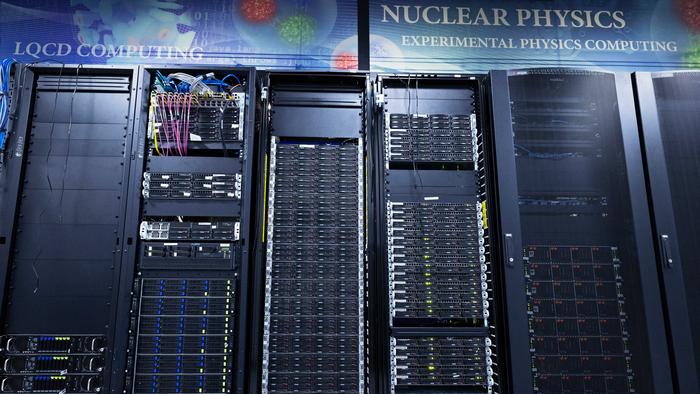Summary: The HadStruc Collaboration, based at Jefferson Lab, has developed a new 3D approach to understanding the structure of hadrons using lattice quantum chromodynamics and supercomputer simulations.
Estimated reading time: 6 minutes
Inside the seemingly solid matter that makes up our world, a dynamic landscape of quarks and gluons interacts to form the building blocks of atomic nuclei. Now, a team of physicists has taken a significant step towards mapping out this subatomic terrain in three dimensions, offering new insights into the fundamental structure of matter.
The HadStruc Collaboration, a group of nuclear theorists based at the U.S. Department of Energy’s Thomas Jefferson National Accelerator Facility (Jefferson Lab), has developed a novel mathematical approach to describe the interactions of partons – the collective term for quarks and gluons. Their findings, recently published in the Journal of High Energy Physics, represent a major advance in our understanding of hadrons, the particles that make up protons and neutrons.
Unveiling the 3D Structure of Hadrons
At the heart of this research is a concept known as generalized parton distributions (GPDs), which offer a three-dimensional view of hadron structure. This approach provides significant advantages over older, one-dimensional models.
“Well, the GPD is much better in the sense that it allows you to elucidate one of the big questions we have about the proton, which is how its spin arises,” explained Hervé Dutrieux, a post-doctoral researcher at William & Mary and member of the HadStruc Collaboration.
The team’s work addresses a longstanding puzzle in particle physics: the origin of proton spin. Since 1987, when experiments showed that quark spin contributes less than half of a proton’s total spin, scientists have been searching for the source of the remaining spin. GPDs offer a promising path to understanding how gluons and the orbital motion of partons contribute to this fundamental property.
Harnessing Supercomputer Power
To test their new approach, the HadStruc team conducted an impressive 65,000 simulations using some of the world’s most powerful supercomputers, including Frontera at the Texas Advanced Computing Center and Frontier at Oak Ridge National Laboratory.
Joseph Karpie, a postdoctoral researcher at Jefferson Lab’s Center for Theoretical and Computational Physics, emphasized the scale of the undertaking: “This was our proof of principle. We wanted to know if the results from these simulations would look reasonable based on what we already know about these particles.”
The simulations required millions of processor hours, showcasing the immense computational resources needed to probe the depths of quantum chromodynamics (QCD), the theory describing the strong nuclear force that binds quarks and gluons.
From Theory to Experiment
The HadStruc Collaboration’s work isn’t just theoretical – it’s already being put to the test in experiments worldwide. Processes such as deeply virtual Compton scattering (DVCS) and deeply virtual meson production (DVMP) are being used to examine hadron structure through GPDs at Jefferson Lab and other facilities.
Looking ahead, the team’s research is expected to play a crucial role in experiments at the upcoming Electron-Ion Collider (EIC) being built at Brookhaven National Laboratory. This new facility promises to probe hadrons at unprecedented levels, potentially validating and expanding upon the HadStruc team’s theoretical work.
Pushing the Boundaries of Prediction
The HadStruc Collaboration’s achievements represent a significant shift in the relationship between theory and experiment in particle physics. Karpie noted the potential for their work to get ahead of experimental capabilities:
“QCD has always lagged behind experiments. We were usually post-dicting instead of pre-dicting what things are happening. So, now if we can actually get ahead — if we can do something that the experimenters can’t do yet—that would be pretty cool.”
As the team continues to refine their calculations and push the boundaries of what’s possible with supercomputer simulations, they’re not just unlocking the secrets of matter’s building blocks – they’re reshaping our understanding of the fundamental forces that govern the universe.
Quiz
- What is the main advantage of using generalized parton distributions (GPDs) over older models?
- How many simulations did the HadStruc team conduct to test their new approach?
- What upcoming facility is expected to further test and expand upon the HadStruc team’s theoretical work?
Answer Key:
- GPDs offer a three-dimensional view of hadron structure and help explain how proton spin arises.
- The team conducted 65,000 simulations.
- The Electron-Ion Collider (EIC) being built at Brookhaven National Laboratory.
Further Reading:
- Thomas Jefferson National Accelerator Facility
- Introduction to Quantum Chromodynamics
- The Electron-Ion Collider Project
Glossary of Terms:
- Hadron: A composite particle made of quarks held together by the strong force.
- Parton: A collective term for quarks and gluons within hadrons.
- Quantum Chromodynamics (QCD): The theory describing the strong nuclear force.
- Generalized Parton Distributions (GPDs): A mathematical framework for describing the 3D structure of hadrons.
- Lattice QCD: A technique for performing QCD calculations on a discrete spacetime lattice.
- Supercomputer: A very powerful computer used for highly complex calculations and simulations.
Enjoy this story? Get our newsletter! https://scienceblog.substack.com/


